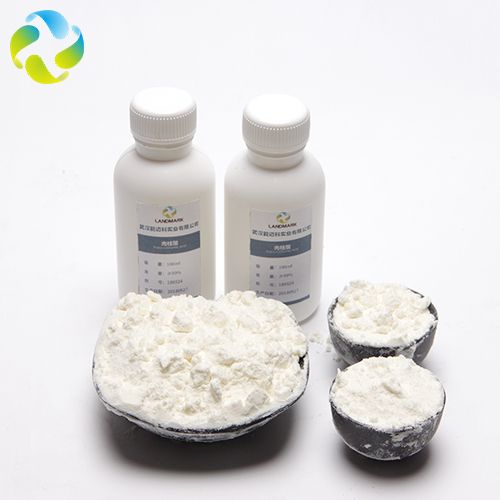

FOB Price
Get Latest Price|
- Minimum Order
Country:
China
Model No:
-
FOB Price:
Place of Origin:
-
Price for Minimum Order:
-
Minimum Order Quantity:
-
Packaging Detail:
-
Delivery Time:
-
Supplying Ability:
-
Payment Type:
-
Product Group :
-
Contact Person Halsey
Wuhan, Hubei
Cinnamic acid is an
organic compound with the formula
C6H5CH=CHCOOH. It is a white crystalline
compound that is slightly soluble in
water, and freely soluble in many organic solvents. Classified
as an unsaturated carboxylic acid, it occurs
naturally in a number of plants. It exists as both a cis and a
trans isomer, although the latter is more
common.
Cinnamic acid is a central intermediate in the
biosynthesis of myriad
natural products
include lignolsto
lignin and
lignocellulose),
flavonoids,isflavonoids, conumarins, aurones, stilbenes,
catechin,and phenylpropanoids.
Its biosynthesis is performed by
action of the enzyme phenylalnine
ammonia-lyase (PAL)
on phenylalanine.
Cinnamic acid is a precursor for the synthesis of a
huge number of plant substances, including lignin, tannins,
flavonoids, pigments, many of the flavor components of spices, and
various alkaloids, such as morphine and
colchicine.
Usage:
Cinnamic acid is an important substance because it is
widely used in perfume, food, photographic, polymer and
pharmaceutical industries, as well as for clinical and
toxicological Studies. Until now, many methods have been reported
for its determination, such as
titrimetry, differential-pulse
polarography,spectrophotometry, mass spectrometry, HPLC, electrokinetic capillary
chromatography, capillary
electrophoresis, gas chromatography
and liquid chromatography. However, there are many disadvantages
over these methods, such as long-response time, reagent
consumption, complicated operation, etc.
1.flavors and fragrances
It can be used as an aromatic mixture in soaps,
shampoos, washing powders, and daily cosmetics.
Cinnamonic acid is used to prepare apples and cherries,
which can be used as apple flavor, cherry flavor, fruit flavor, and
floral fragrance. It has the effect
of inhibiting the formation of black tyrosinase, has a certain
insulating effect on ultraviolet rays, can make brown spots lighter
or even disappear, and is one of the essential ingredients in
advanced sunscreen. Cinnamic acid
itself is a kind of spice, which has a good aroma-retaining effect.
It is usually used as a raw material for fragrant, which makes the
aroma of the main fragrance more volatile.
2.the pharmaceutical industry
In the pharmaceutical industry, it can be used as an
important drug for the synthesis and treatment of coronary heart
disease. It can be used as a heart-to-heart and heart-to-heart, as
well as synthetic chlorpheniric acid and cinnamyl piperazine. It
can be used to make "Xin Kean", local anesthetic, fungicide,
hemostasis. Medicine, etc. Chlorobenamide and cinnamyl piperazine
can also be synthesized for use as a spine bone relaxant and an
antispasmodic agent. Mainly used for cerebral thrombosis, cerebral
arteriosclerosis, coronary artery cirrhosis and other diseases. It
has a significant inhibitory effect on the proliferation of lung
adenocarcinoma cells.
3.organic synthesis
In terms of organic chemical synthesis, cinnamic acid
can be used as a sustained release agent for galvanized sheets, a
heat stabilizer for polyvinyl chloride, a crosslinker for
polyurethane, a flame retardant for hydantoin and polycaprolactam,
and a chemical analysis reagent. It is also a reagent for
determining the separation of uranium and vanadium; it is also the
most important synthetic raw material for negative-type
photosensitive resins. The main synthetic lauric acid ester,
polyvinyl alcohol cinnamate, ethyl ethoxy cinnamate and epoxy resin
with pendant cinnamate.Used in plastics, it can be used as heat
stabilizer for PVC, anti-mold and deodorant for sterilizing, and
can also be added into rubber and foam to make deodorant shoes and
insoles. It can also be used for cotton and various synthetic
fibers, leather and paint. Prevent mildew in products such as shoe
polish and straw mats.
| Country: | China |
| Model No: | - |
| FOB Price: | Get Latest Price |
| Place of Origin: | - |
| Price for Minimum Order: | - |
| Minimum Order Quantity: | - |
| Packaging Detail: | - |
| Delivery Time: | - |
| Supplying Ability: | - |
| Payment Type: | - |
| Product Group : | - |